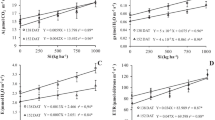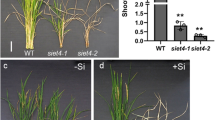Abstract
Aims
Rice is a well-known silica-accumulating plant. The dumbbell-shaped silica bodies in the silica cells in rice leaf epidermis are formed via biosilicification, but the underlying mechanisms are largely unknown.
Methods
Leaves at different developmental stages were collected to investigate silica cell differentiation by analyzing structures and silicon localization in the silica cells.
Results
Exogenous silicon application increased both shoot and root biomass. When silicon was supplied, silica cells in the leaf epidermis developed gradually into a dumbbell-shape and became increasingly silicified as leaves aged. Silicon deposition in the silica cells was not completed until the leaf was fully expanded. Multiple lines of evidence suggest that lignification of silica cell walls precedes silicon deposition in the lumen of silica cells. The organized needle-like silica microstructures were formed by moulding the inner cell walls and filling up the lumen of the silica cell following leaf maturation.
Conclusions
Two processes were involved in silicon deposition: (1) the silica cell wall was lignified and silicified, and then (2) the silicon was deposited gradually in silica cells as leaves aged. Silica body formation was not completed until the leaf was fully mature.








Similar content being viewed by others
References
Ball TB, Brotherson JD, Garder JS (1993) A topologic and morphometric study of variation in idioblasts from inkhorn wheat (Triticum monococcum L.). Can J Bot 71:1182–1192
Ball TB, Gardner JS, Anderson N (1999) Identifying inflorescence idioblasts from selected species of wheat (Triticum Monococcum, T. Dicoccon, T. Dicoccoides, and T. Aestivum) and Barley (Hordecum Vulgare and H. Spontaneum) (Gramineae). Am J Bot 86:1615–1623
Barber DA, Shone MT (1966) The absorption of silica from aqueous solution by plant. J Exp Bot 17:569–578
Berlyn GP, Mickshe JP (1976) Botanical microtechnique and cytochemistry. Iowa State University Press, Ames
Blackman E (1968) The pattern and sequence of opaline silica deposition in Rye (Secale cereale L.). Ann Bot 32:207–218
Cooke J, Leishman MR (2011) Is plant ecology more siliceous than we realise? Trends Plant Sci 16:61–68
Cooke J, Leishman MR (2012) Tradeoffs between foliar silicon and carbon-based defenses: evidence from vegetation communities of contrasting soil types. Oikos 121:2052–2060
Coradin T, Lopez PJ (2003) Biogenic silica patterning: simple chemistry or subtle biology. ChemBioChem 4:251–259
Crabtree RH (1998) A new type of hydrogen bond. Science 282:2000–2001
Currie HA, Perry CC (2007) Silica in plants: biological, biochemical and chemical studies. Ann Bot 100:1383–1389
Dayananda P, Kaufman PB, Franklin CI (1983) Detection of silica in plants. Am J Bot 70:1079–1084
Epstein E (1999) Silicon. Annu Rev Plant Physiol Plant Mol Biol 50:641–664
Harrison CC (1996) Evidence for intramineral macromolecules containing protein from plant silicas. Phytochemistry 41:37–42
Hartley RD, Jones LHP (1972) Silicon compounds in xylem exudates of plants. J Exp Bot 23:637–640
Hodson MJ, Sangster AG (1988) Observation on the distribution of mineral elements in the leaf of wheat (Triticum aestivum L.), with particular reference to silicon. Ann Bot 62:463–471
Hodson MJ, Sangster AG, Parry DW (1985) An ultrastructural study on the developmental phases and silicification of the glume of Phalaris canariensis L. Ann Bot 55:649–655
Hodson MJ, White PJ, Mead A, Broadley MR (2005) Phylogenetic variation in the silicon composition of plants. Ann Bot 96:1027–1046
Horst WJ, Marshner H (1978) Effect of silicon on manganese tolerance of beans plants (Phaseolus vulgaris L.). Plant Soil 50:287–304
Iler RK (1979) The chemistry of silica: solubility, polymerization, colloid and surface properties, and biochemistry. JohnWiley&Sons, NewYork
Inanaga S, Okasaka A (1995) Calcium and silicon binding compounds in cell walls of rice shoots. Soil Sci Plant Nutr 41:103–110
Kaufman PB, Petering LB, Smith JG (1970) Ultrastructural development of cork-silica cell pairs in Avena internodal epidermis. Bot Gaz 131:173–185
Kaufman PB, Dayanandan P, Takeoka Y, Bigelow WC, Jones JD, Iler R (1981) Silica in shoots of higher plants. In: Simpson TL, Volcani BE (eds) Silicon and siliceous structures in biological systems. Springer, New York, pp 409–449
Kaufman PB, Dayanandan P, Franklin CI, Takeoka Y (1985) Structure and function of silica bodies in the epidermal system of grass shoots. Ann Bot 55:487–507
Kauss H, Seehaus K, Franke R, Gilbert S, Robert A, Kröger N (2003) Silica deposition by a strongly cationic proline-rich protein from systemically resistant cucumber plants. Plant J 33:87–96
Keeping MG, Kvedaras OL (2008) Silicon as a plant defence against insect herbivory: response to Massey, Ennos and Hartley. J Anim Ecol 77:631–633
Korndörfer GH, Lepsch I (2001) Effect of silicon on plant growth and crop yield. In: Datnoff LE, Snyder GH, Korndörfer GH (eds) Silicon in agriculture. Elsevier Press, Amsterdam, pp 133–147
Kröger N (2007) Prescribing diatom morphology: toward genetic engineering of biological nanomaterials. Curr Opin Chem Biol 11:662–669
Kröger N, Lenhmann G, Rachel R, Sumper M (1997) Characterization of a 200-kDa diatom protein that is specifically associated with a silica-based substructure of the cell wall. Eur J Biochem 250:99–105
Kröger N, Deutzmann R, Sumper M (1999) Polycationic peptides from diatom biosilica that direct silica nanosphere formation. Science 286:1129–1132
Kröger N, Deutzmann R, Bergsdorf C, Sumper M (2000) Species-specific polyamines from diatoms control silicamorphology. Proc Natl Acad Sci USA 97:14133–14138
Kröger N, Deutzmann R, Sumper M (2001) Silica-precipitating peptides from diatoms. The chemical structure of silaffin-A from Cylindrotheca fusiformis. J Biol Chem 276:26066–26070
Liang YC, Wong JWC, Wei L (2005a) Silicon-mediated enhancement of cadmium tolerance in maize (Zea mays L.) grown in cadmium contaminated soil. Chemosphere 58:475–483
Liang YC, Si J, Römheld V (2005b) Silicon uptake and transport is an active process in Cucumis sativus. New Phytol 167:797–804
Lopez PJ, Desclés J, Allen AE, Bowler C (2005) Prospects in diatom research. Curr Opin Biotechnol 16:180–186
Lux A, Luxová M, Morita S, Abe J, Inanaga S (1999) Endodermal silicification in developing seminal roots of lowland and upland cultivars of rice (Oryza sativa L.). Can J Bot 77:955–960
Lux A, Luxova M, Abe J, Tanimoto E, Hattori T, Inanaga S (2003) The dynamics of silicon deposition in the sorghum root endodermis. New Phytol 158:437–441
Ma JF, Takahashi E (2002a) Functions of silicon in plant growth. In: Soil, fertilizer, and plant silicon research in Japan. Elsevier Press, Amsterdam pp 5–26
Ma JF, Takahashi E (2002b) Silicon uptake and accumulation in plants. In: Soil, fertilizer, and plant silicon research in Japan. Elsevier Press, Amsterdam pp 73–106
Ma JF, Tamai K, Yamaji N, Mitani N, Konishi S, Katsuhara M, Murata Y, Yano M, Ishiguro M (2006) A silicon transporter in rice. Nature 440:688–691
Ma JF, Yamaji N, Mitani N, Tamai K, Konishi S, Fujiwara T, Katsuhara M, Yano M (2007) An efflux transporter of silicon in rice. Nature 448:209–213
Massey FP, Hartley SE (2009) Physical defences wear you down: progressive and irreversible impacts of silica on insect herbivores. J Anim Ecol 78:281–291
Milligan AJ, Morel FM (2002) A proton buffering role for silica in diatoms. Science 297:1848–1850
Mitani N, Ma JF (2005) Uptake system of silicon in different plant species. J Exp Bot 56:1255–1261
Motomura H, Fuji T, Suzuki M (2004) Silica deposition in relation to ageing of leaf tissues in Sasa veitchii (Carrière) rehder (Poaceae: Bambusoideae). Ann Bot 93:235–248
Motomura H, Fuji T, Suzuki M (2006) Silica deposition in abaxial epidermis before the opening of leaf blades of Pleioblastus chino (Poaceae, Bambusoideae). Ann Bot 97:513–519
Parry DW, Smithson F (1958) Techniques for studying opaline silica in grass leaves. Ann Bot 22:543–549
Parry DW, Hodson MJ, Newman RH (1985) The distribution of silicon deposits in the fronds of pteridium aquilinum L. Ann Bot 55:77–83
Perry CC, Keeling-Tucker T (1998) Crystalline silica prepared at room temperature from aqueous solution in the presence of intrasilica bioextracts. Chem Commun 23:2587–2588
Perry CC, Keeling-Tucker T (2000) Biosilicification: the role of the organic matrix in structure control. J Biol Inorg Chem 5:537–550
Perry CC, Willeams RJP, Fry SC (1987) Cell wall biosynthesis during silicifation of grass hairs. J Plant Physiol 126:437–448
Piperno DR (2006) The production, deposition, and dissolution of phytoliths. In: Phytoliths: A comprehensive guide for archaeologists and paleoecologists. AltaMira Press, Lanham pp 1–37
Piperno DR, Pearsall DM, Benfer RA Jr, Kealhofer L, Zhao ZJ, Jiang QH (1999) Idioblast morphology. Science 283:S1265–S1266
Poulsen N, Sumper M, Kröger N (2003) Biosilica formation in diatoms: characterization of native silaffin-2 and its role in silica morphogenesis. Proc Natl Acad Sci USA 100:12075–12080
Reynolds EW (1963) The use of lead citrate at high pH as an electron-opaque stain electron microscopy. J Cell Biol 17:208–212
Rogalla H, Römheld V (2003) Role of leaf apoplast in silicon-mediated manganese tolerance of Cucumis sativus L. Plant Cell Environ 25:549–555
Sakai WS, Sanford WG (1984) A developmental study of silicification in the abaxial epidermal cells of sugarcane leaf blades using scanning electron microscope and energy dispersive X-ray analysis. Am J Bot 71:1315–1322
Sangster AG (1978) Silicon in the roots of higher plants. Am J Bot 65:929–935
Sangster AG, Parry DW (1976) Endodermal silicon deposits and their linear distribution in developing roots of Sorghum bicolor (L) Moench. Ann Bot 40:361–371
Sangster AG, Parry DW (1981) Ultrastructure of silica deposits in higher plants. In: Simpson TL, Volcani BE (eds) Silicon and siliceous structures in biological systems. Springer, New York, pp 383–407
SAS Institute Inc (1989) Introductory guide for personal computers, version 6.12 edition. SAS Institute Inc, USA
Shetty R, Jensen B, Shetty NP, Hansen M, Hansen CW, Starkey KR, Jorgensen HJL (2012) Silicon induced resistance against powdery mildew of roses caused by Podeosphaera Pannosa. Plant Pathol 61:120–131
Shi XH, Zhang CC, Wang H, Zhang FS (2005) Effect of Si on the distribution of Cd in rice seedlings. Plant Soil 272:53–60
Sposito G (1989) The chemistry of soils. Oxford Univ. Press, New York, p 277
Sugimura Y, Mori T, Nitta I, Kotani E, Furusawa T, Tatsumi M, Kusakari S, Wada M, Morita Y (1999) Calcium deposition in idioblasts of mulberry leaves. Ann Bot 83:543–550
Waterkeyn L, Bienfait A, Peeters A (1982) Callose silica epidermiques: rapports avec la transpiration cuticularie. Cellule 73:267–287
Yamaji N, Ma J (2008) A transporter regulating silicon distribution in rice shoots. Plant Cell 20:1381–1389
Yeo AR, Flowers SA, Rao G, Welfare N, Senanayake N, Flowers TJ (1999) Silicon reduces sodium uptake in rice (Oryza sativa L.) in saline conditions and this is accounted for by a reduction in the transportational bypass flow. Plant Cell Environ 22:559–565
Yoshida S, Ohinshi Y, Kitagishi K (1962) Chemical forms, mobility and deposition of silicon in rice plant. Soil Sci Plant Nutr 8:15–21
Yoshida S, Forno DA, Cock JH, Cock JH, Gomez KA (1976) Routine procedure for growing rice plants in culture solution. In: Laboratory manual for physiological studies of rice, 3th edn. The International Rice Research Institute, Philippines. pp 61–66
Zhang WX, Wang LL (1998) Idioblast in leaves of 7 Oryza species. J China Agric Univ 3:21–25 (in Chinese)
Acknowledgment
This study was funded by Innovative Group Grant 31121062 from the National Natural Science Foundation of China, and the National Natural Science Foundation of China (G30170550). We thank Dr. D. Zhang, Ms. H. Zhou, Ms. F. Hao and Mr. Y. Yan for their kind helps in preparing the samples and conducting the microanalysis with the SEM-EDX-ray and TEM-EDX-ray. We also thank Dr. Y. Lu and Dr. A. Henry for their help in correcting English writing. The English in this document has been checked by at least two professional editors, both are native English speakers. We also thank the two anonymous reviewers for their comments.
Author information
Authors and Affiliations
Corresponding author
Additional information
Responsible Editor: Philip John White.
Rights and permissions
About this article
Cite this article
Zhang, C., Wang, L., Zhang, W. et al. Do lignification and silicification of the cell wall precede silicon deposition in the silica cell of the rice (Oryza sativa L.) leaf epidermis?. Plant Soil 372, 137–149 (2013). https://doi.org/10.1007/s11104-013-1723-z
Received:
Accepted:
Published:
Issue Date:
DOI: https://doi.org/10.1007/s11104-013-1723-z




